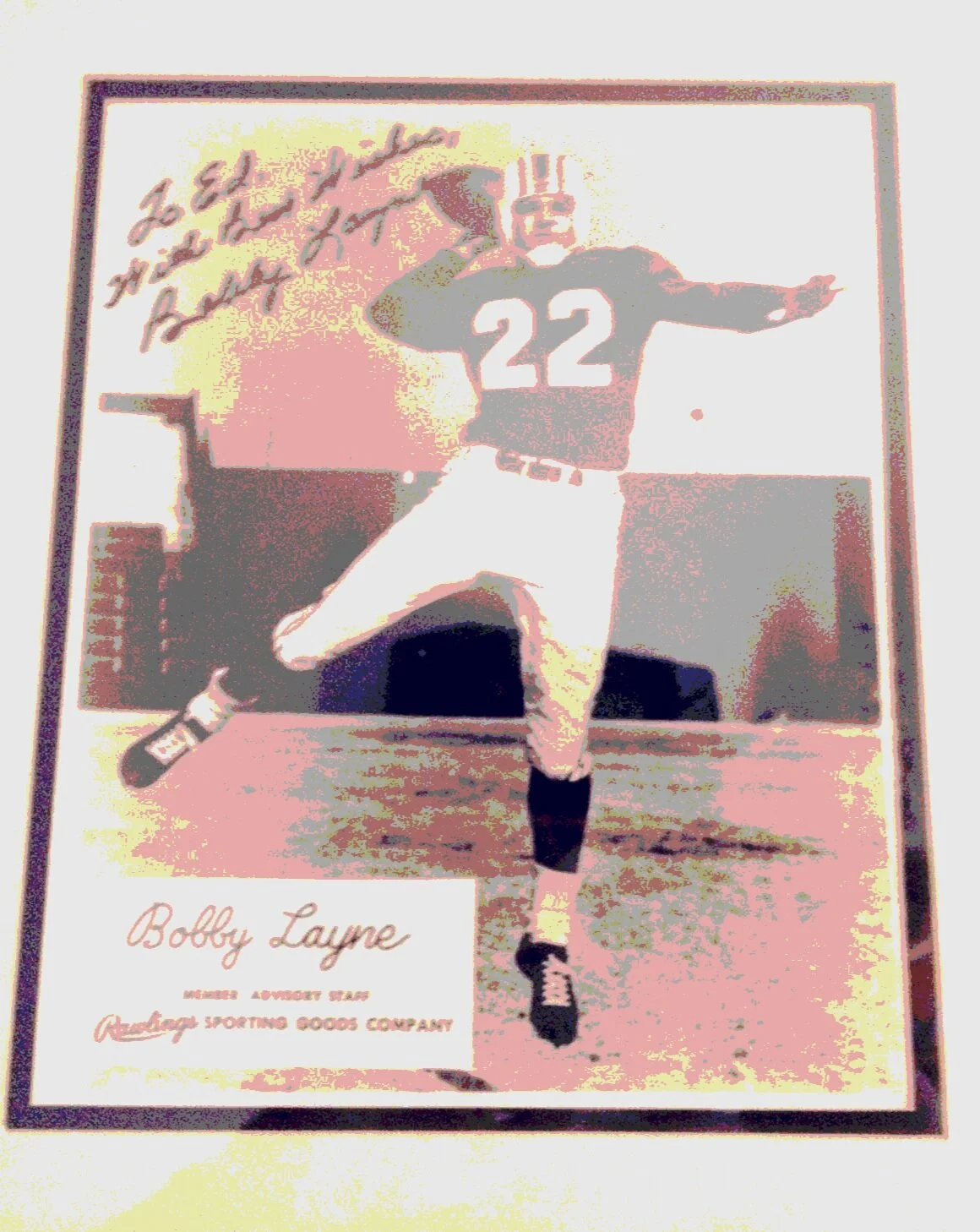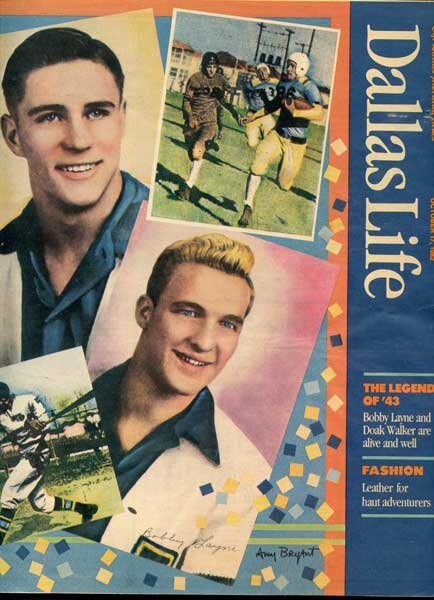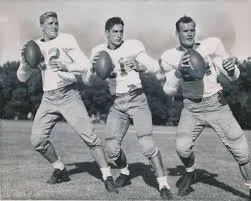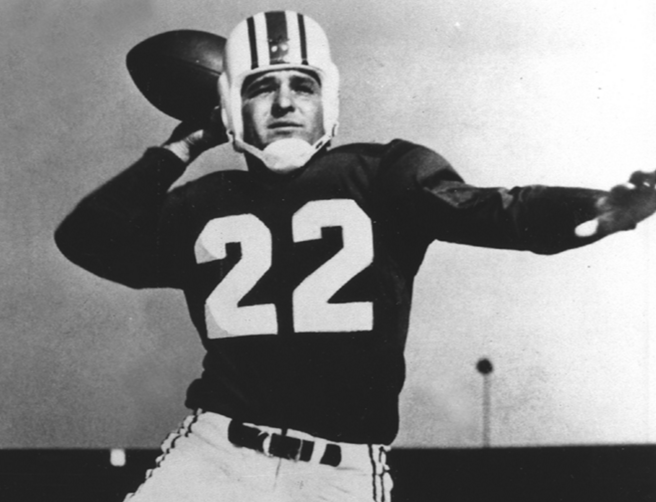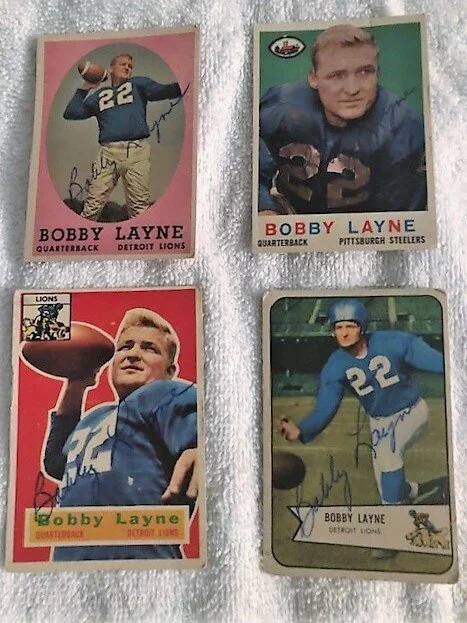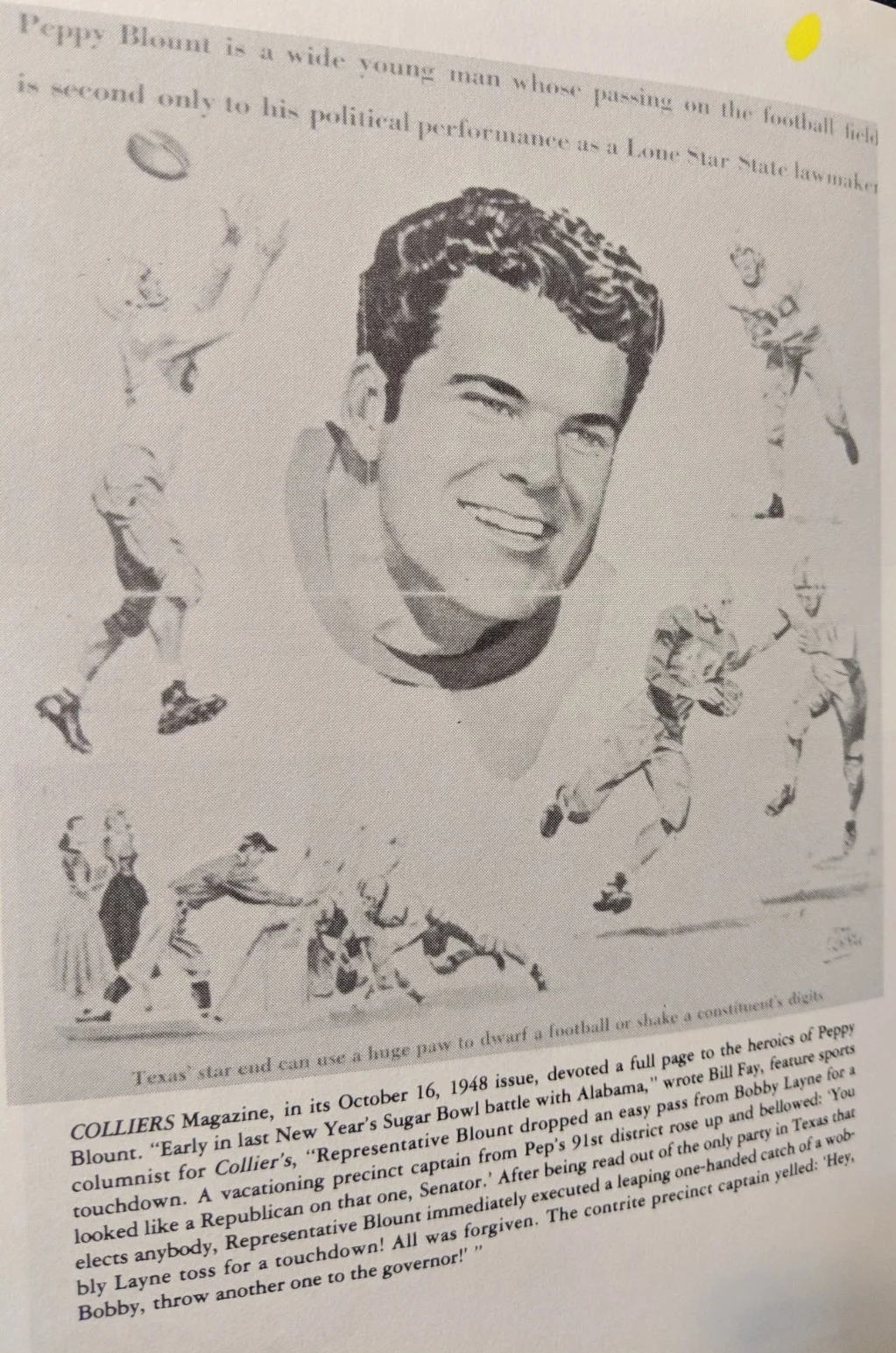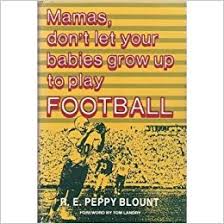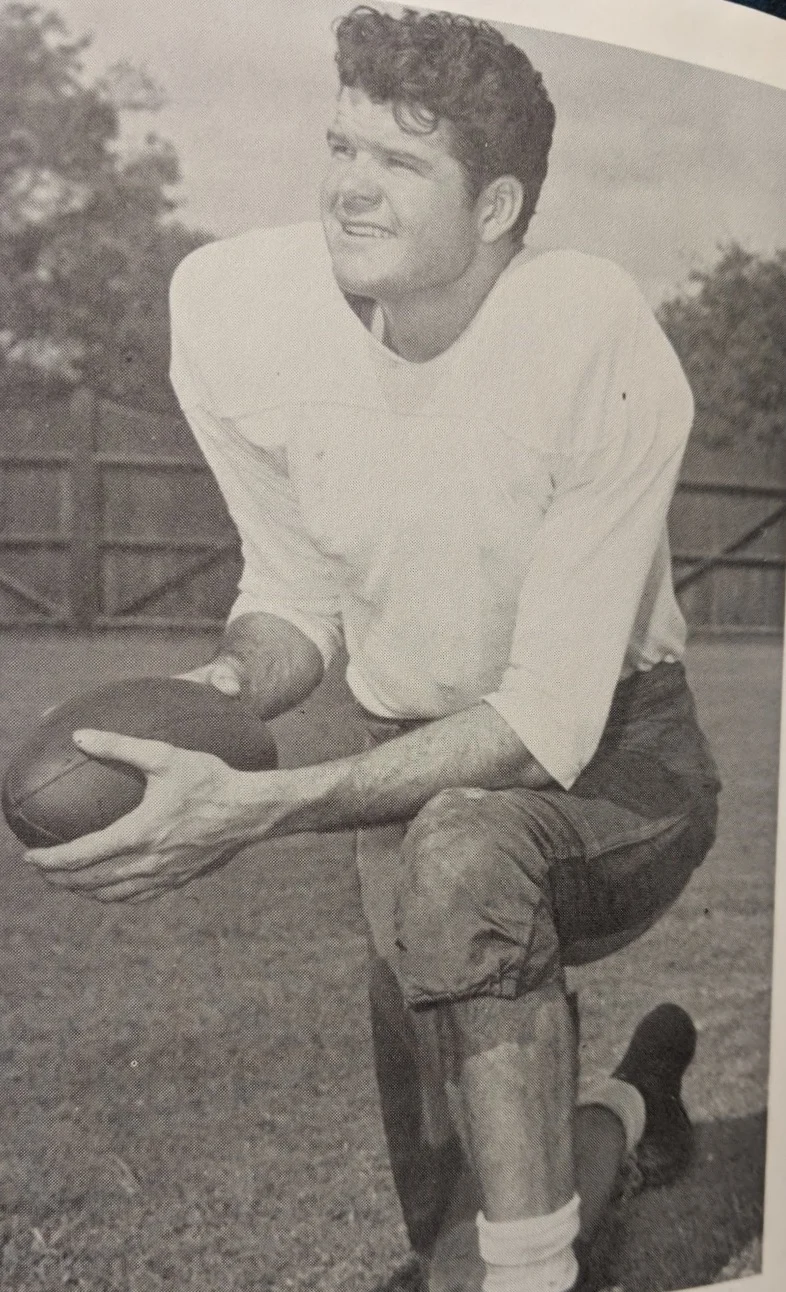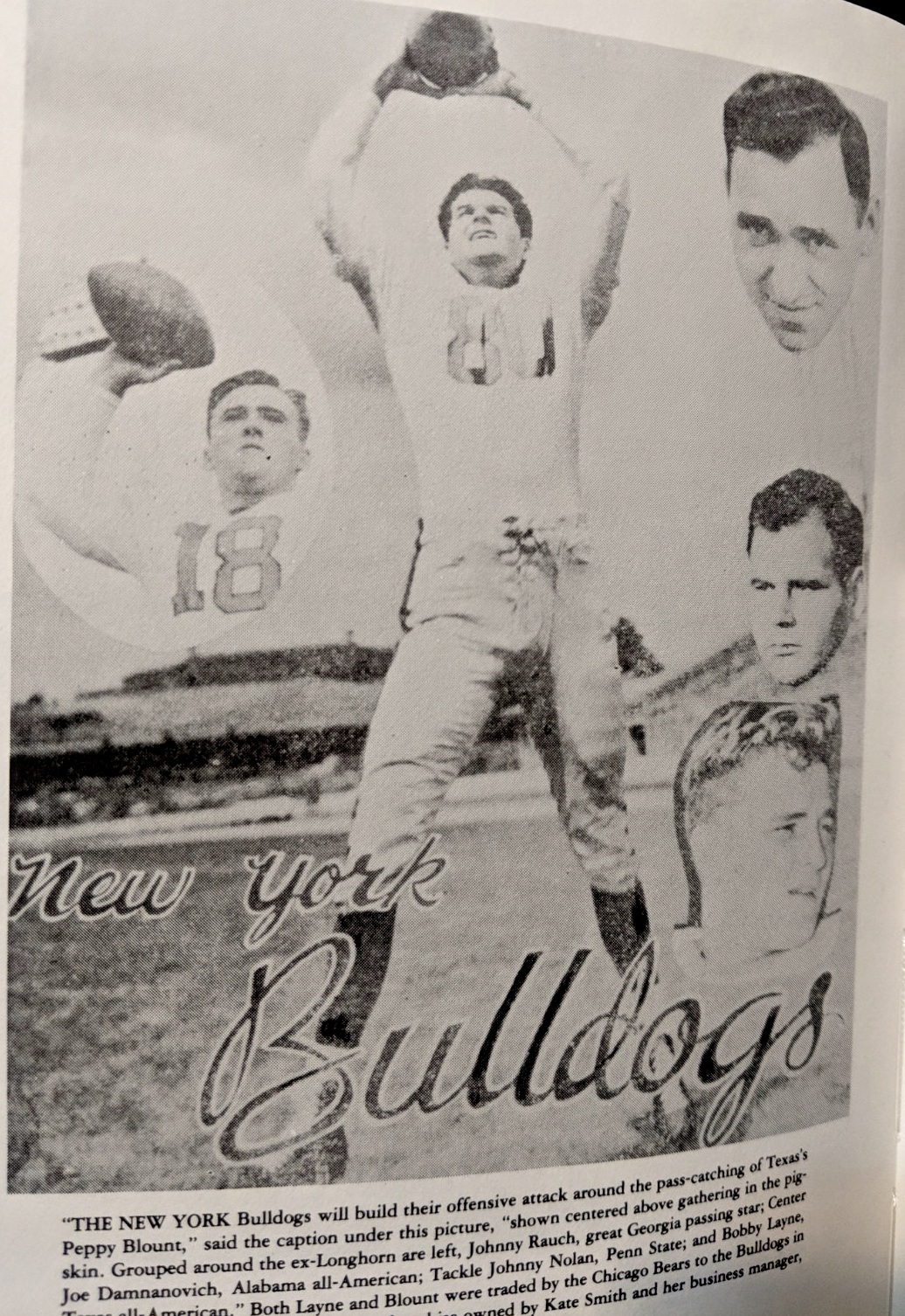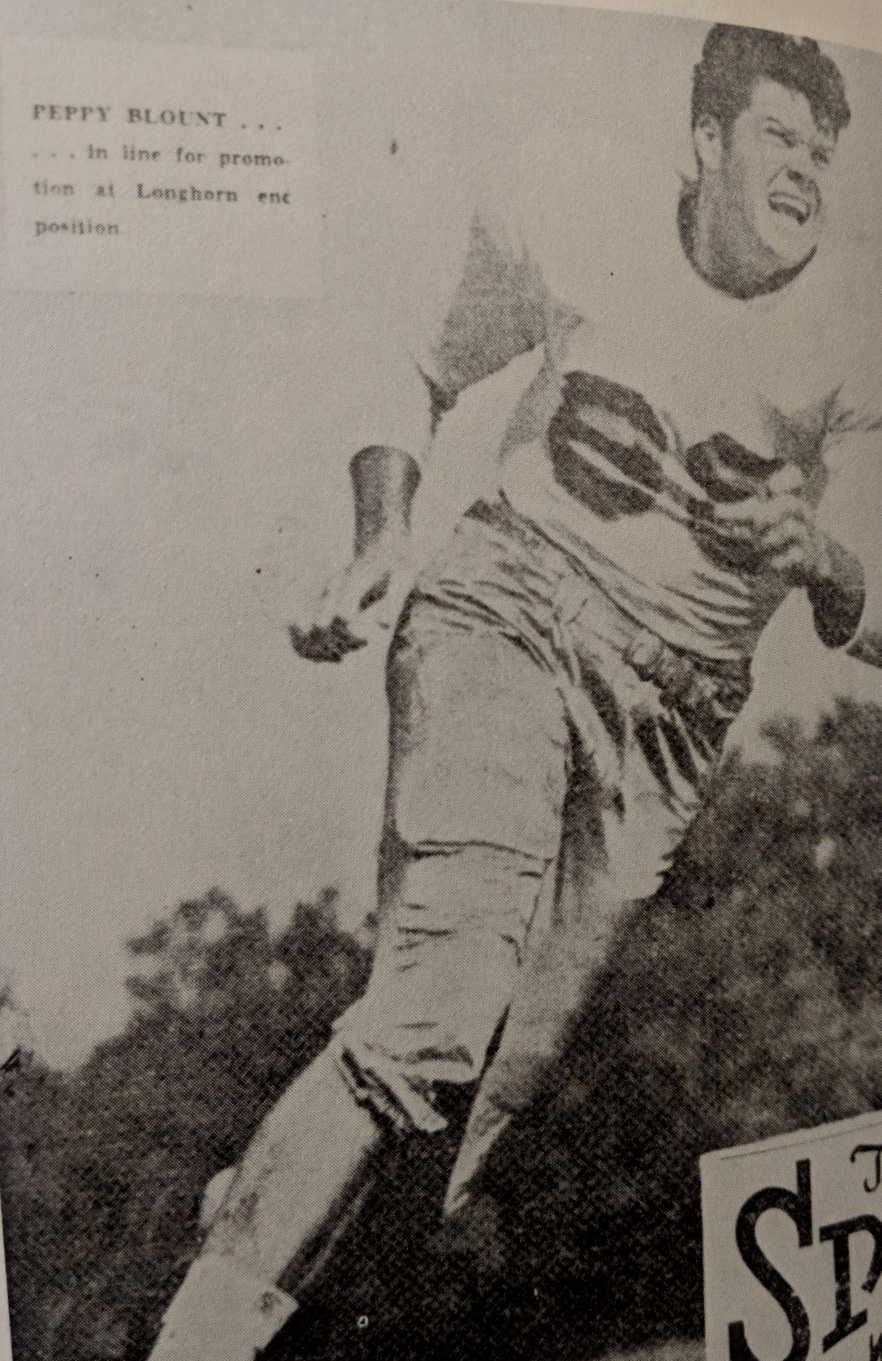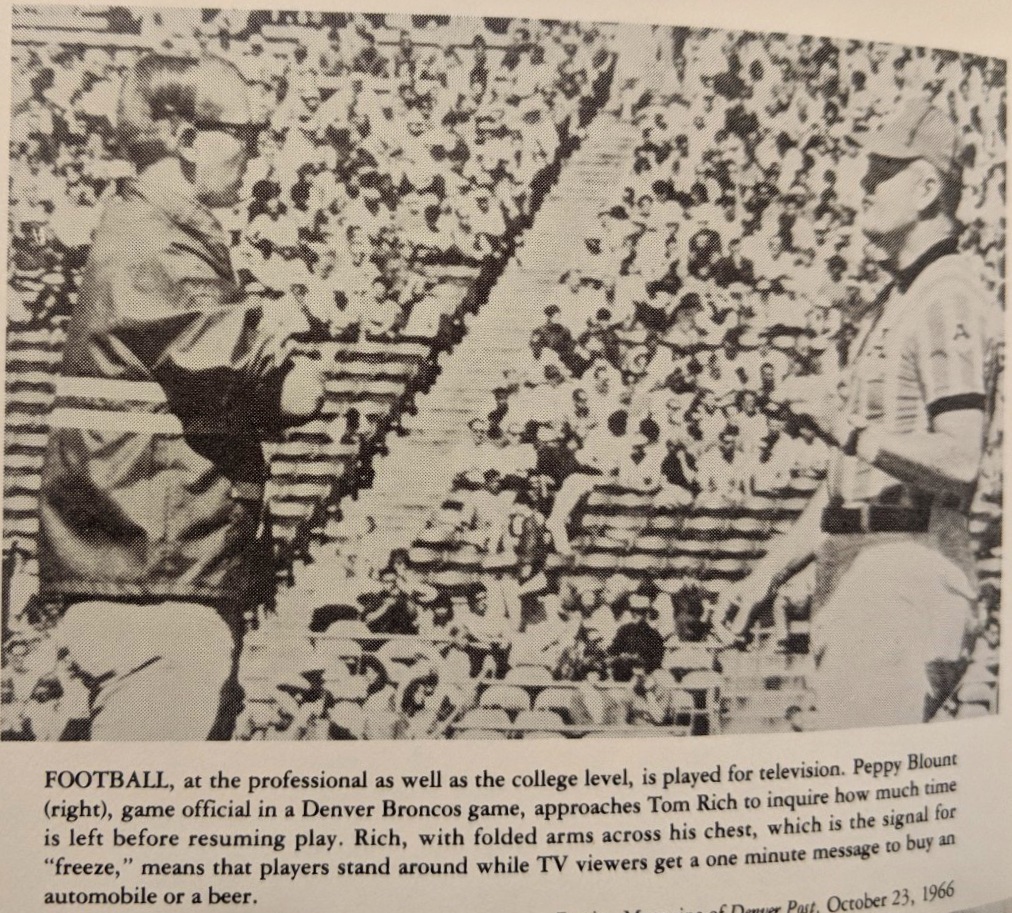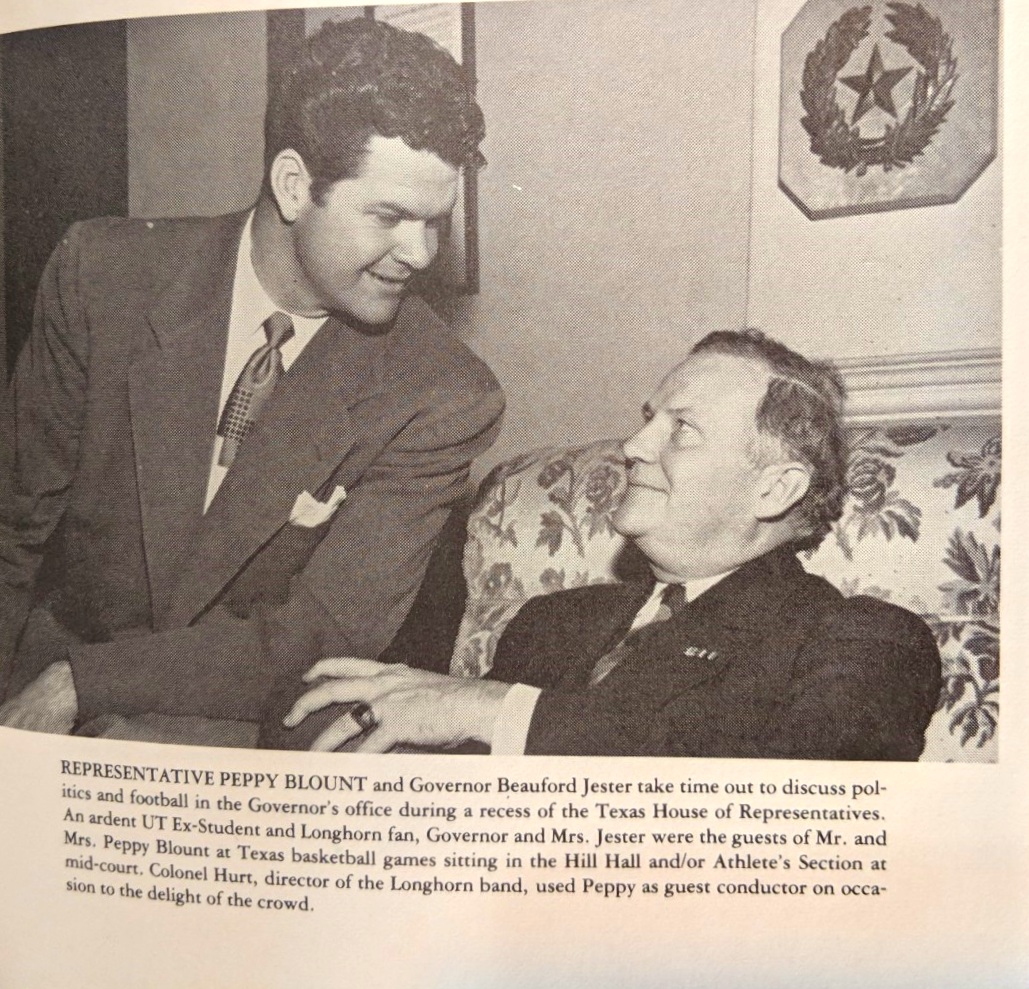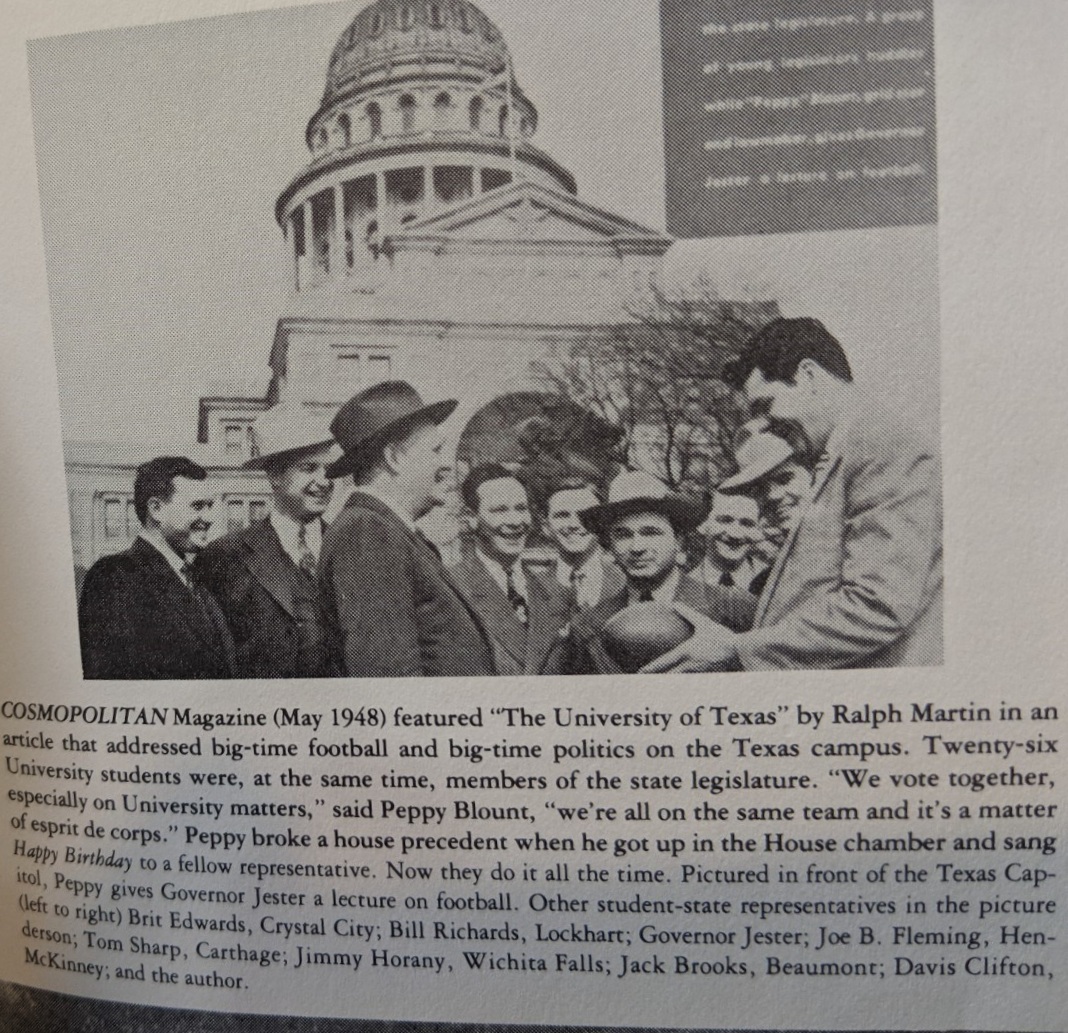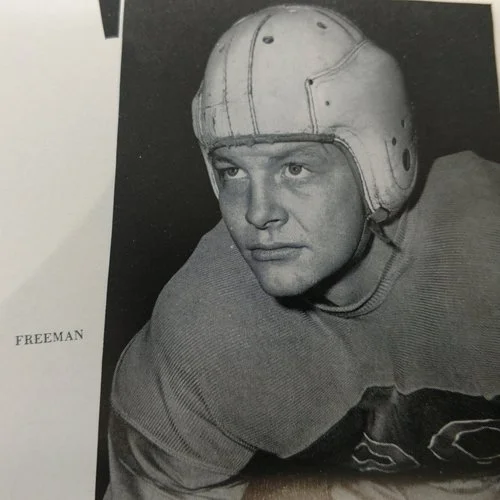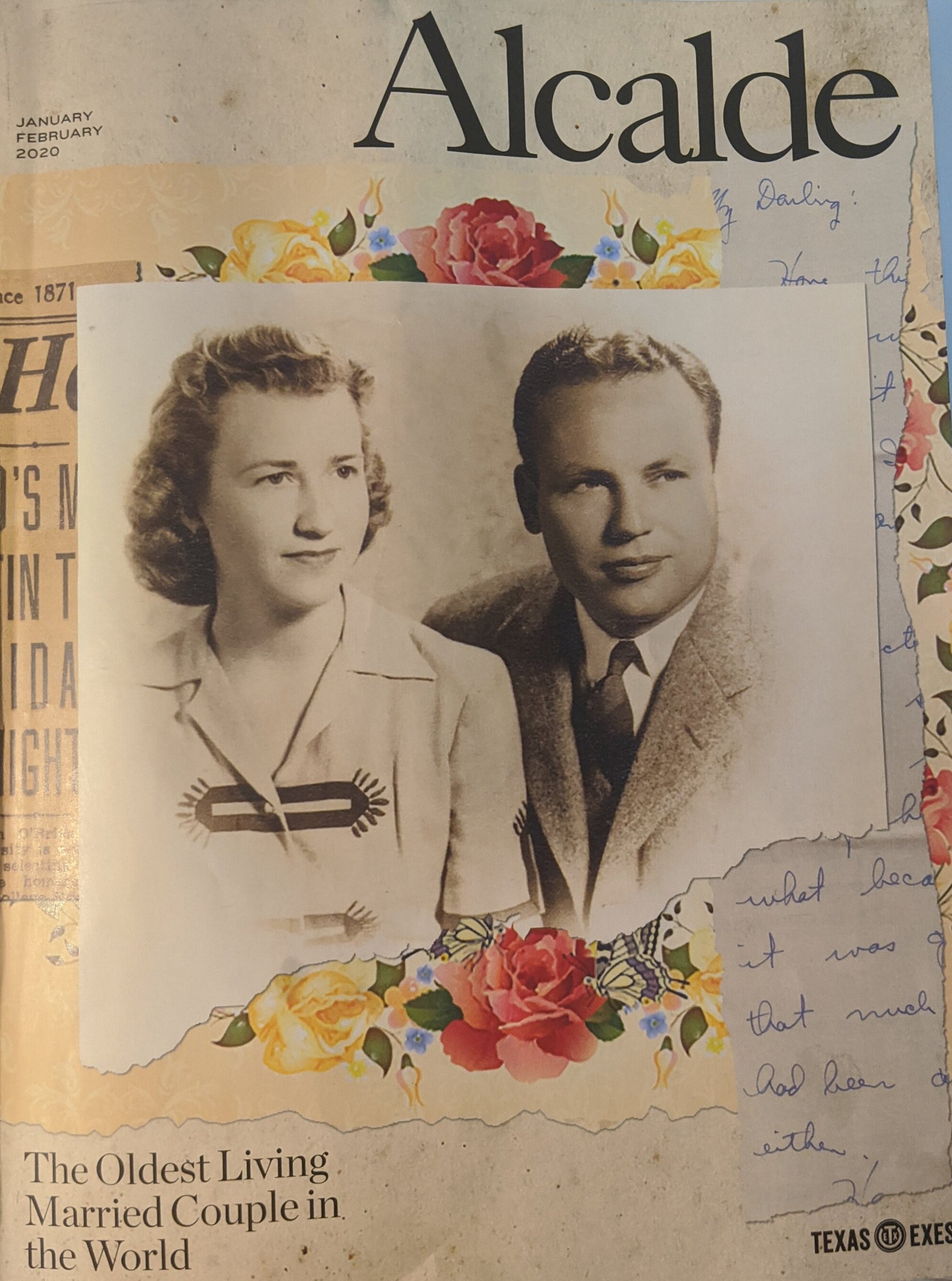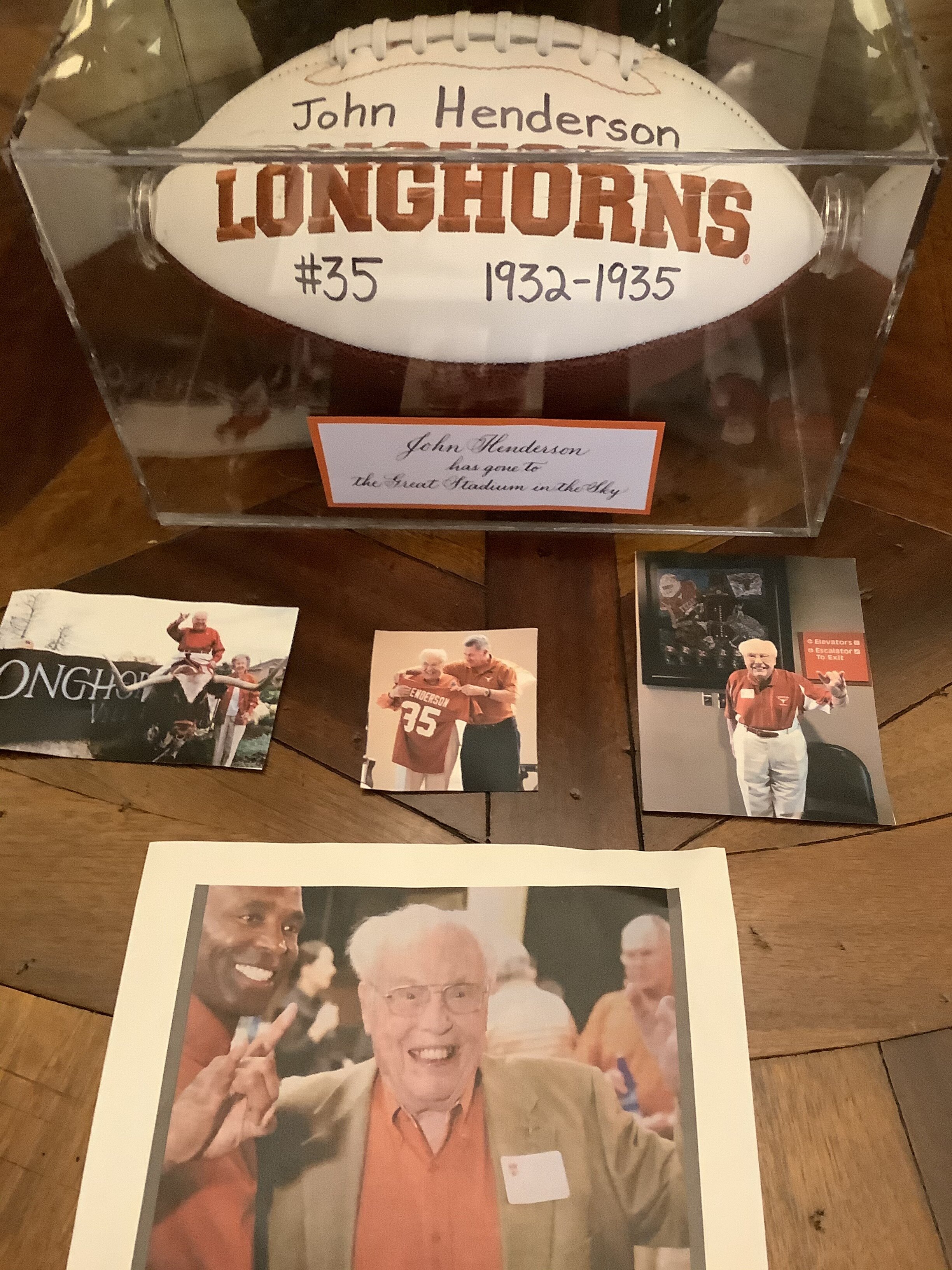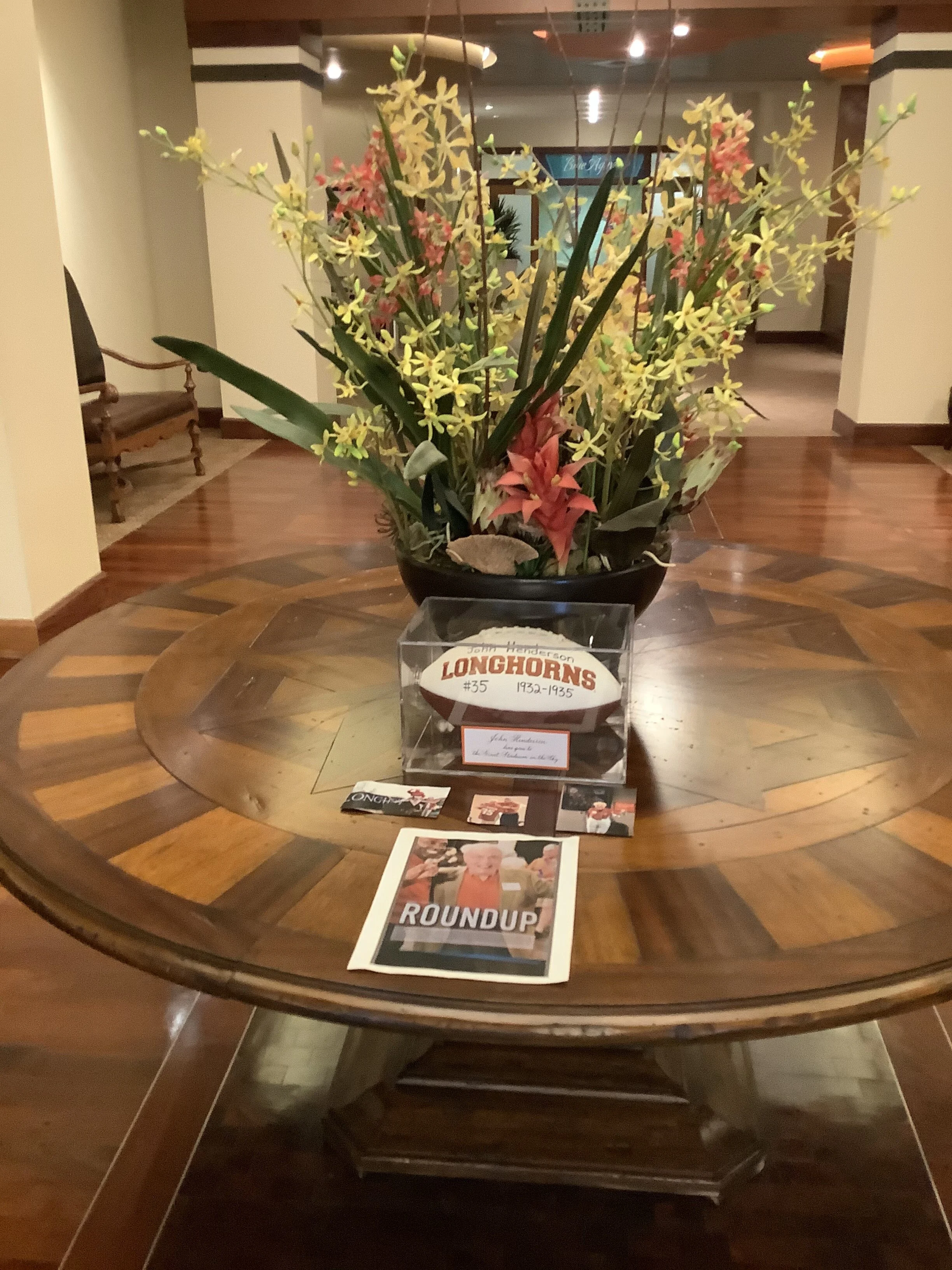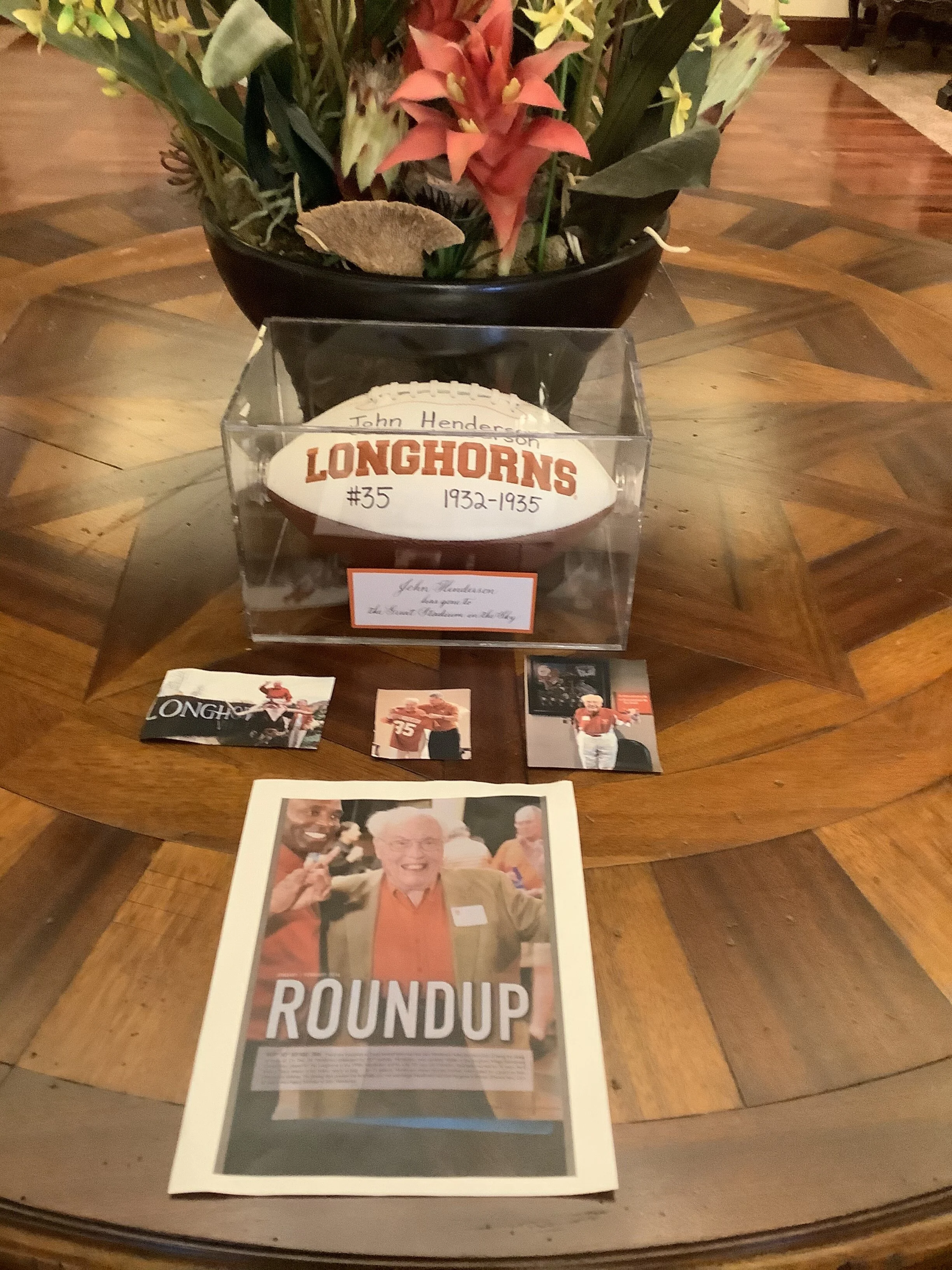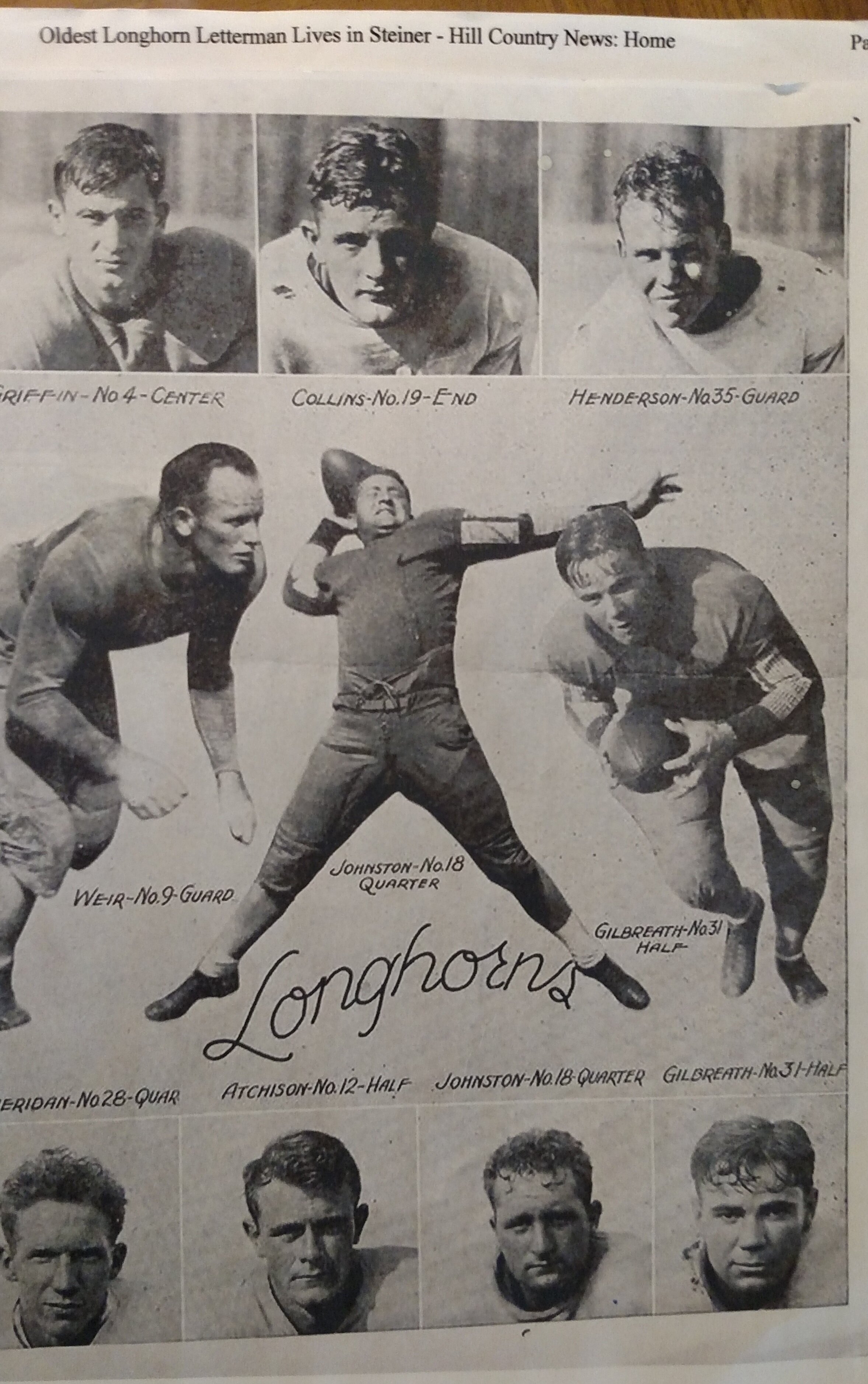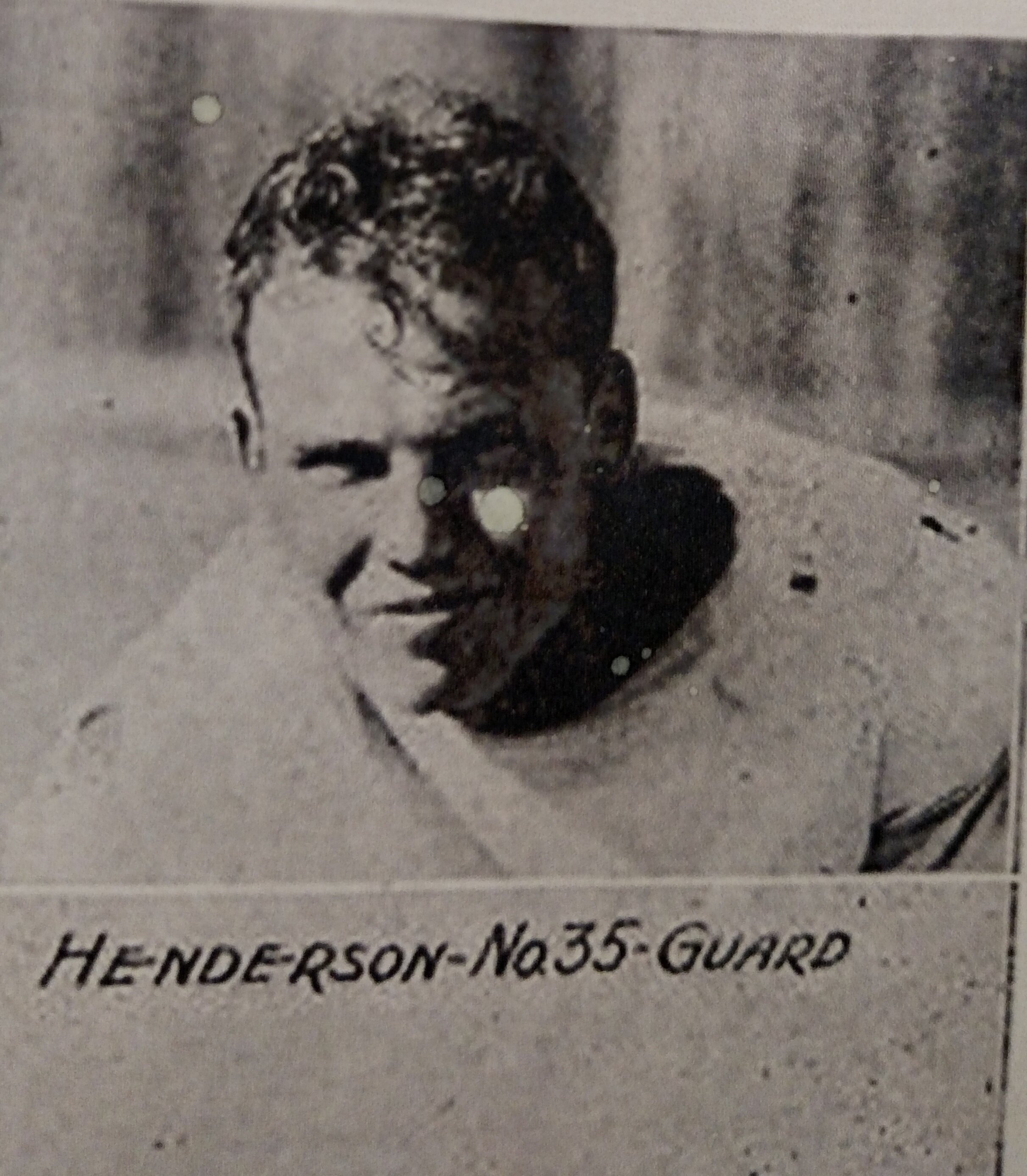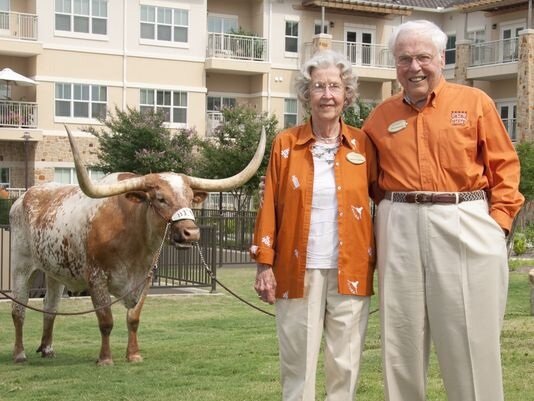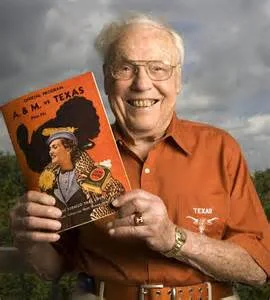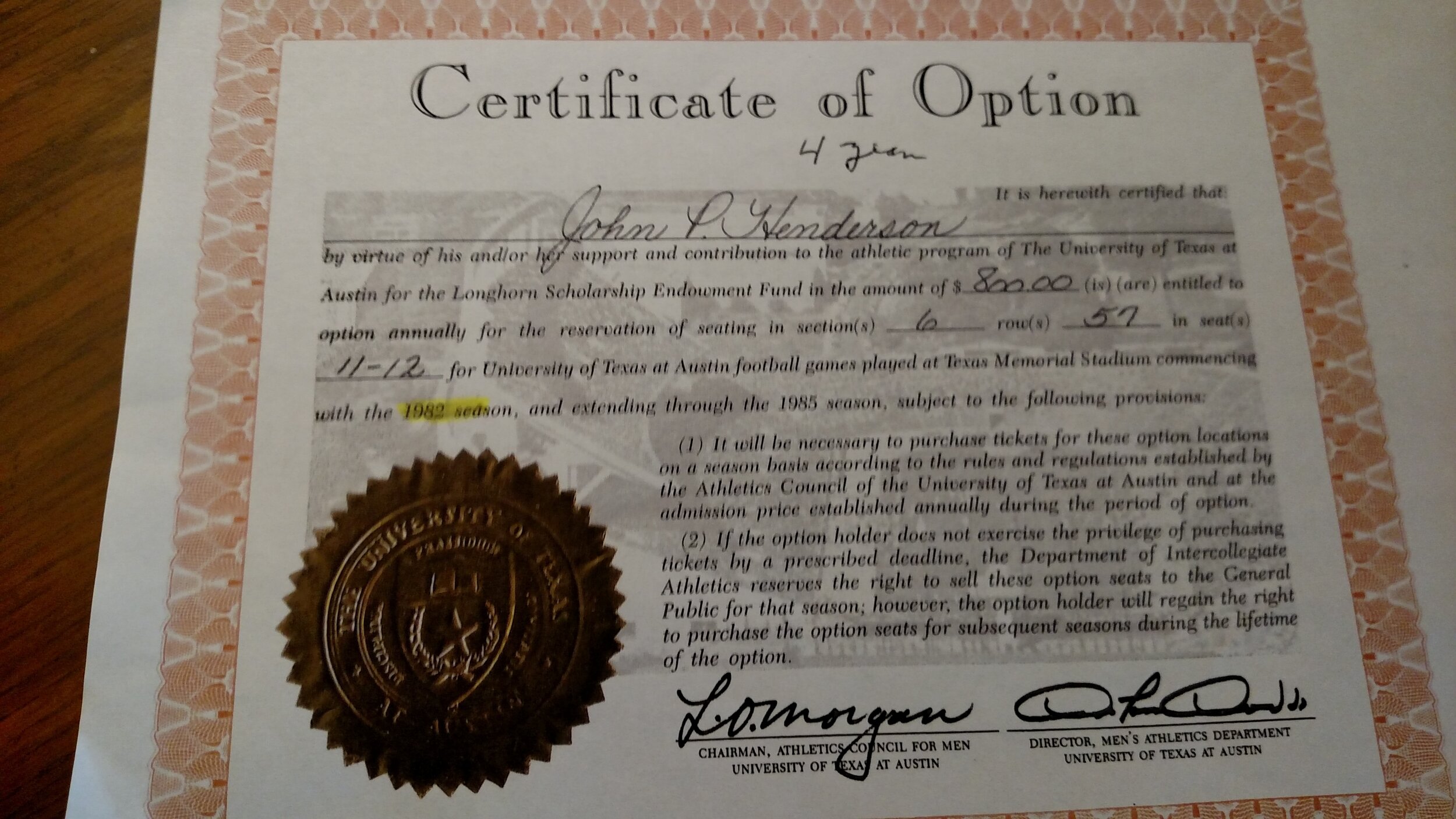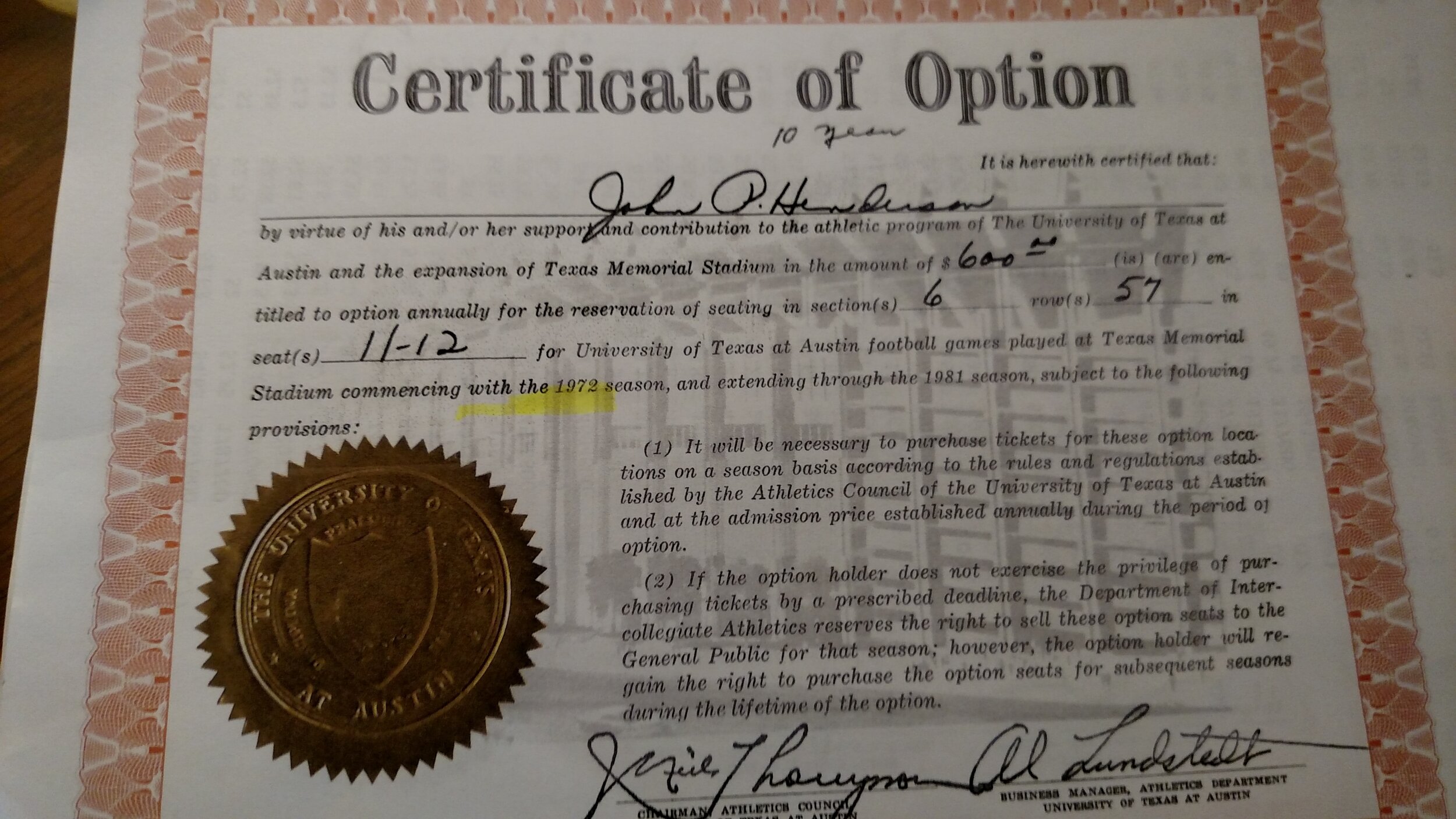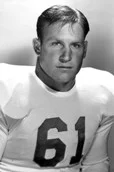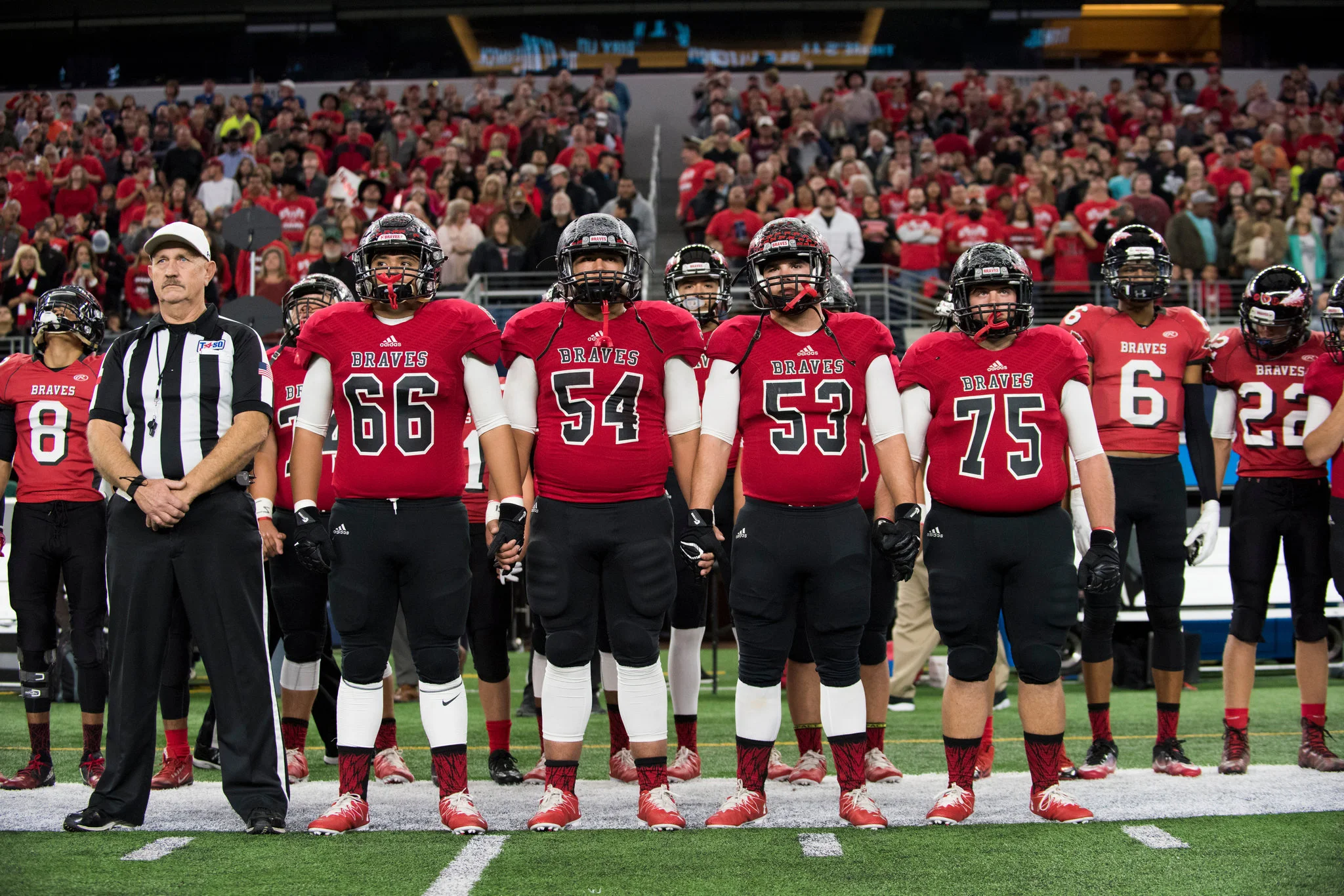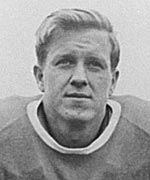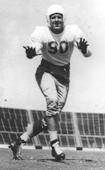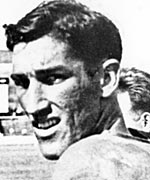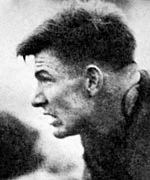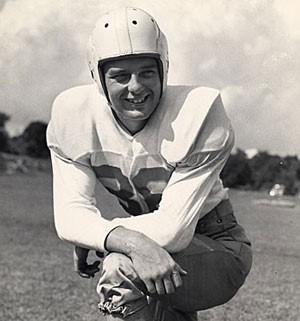Pre- 1950's Football T-Ring Reflections
By Harry Hilgers for Tim Taylor
Every so often, the extraordinary intangible rewards of writing this weekly epistle provide me with something really special. This year, I have already received such reward. On the Friday morning after the first newsletter went out, I got an email from a gentleman named Harry Hilgers, who sent a very nice note that included “I am a 94 year old, former player at U.T. and high school football coach that still loves U.T. and football at the college level but not the pro type.” Intrigued, we exchanged emails, and I suggested that it would be great to include something from him in one of my newsletters. Mr. Hilgers obliged, and I am pleased to include it here.
When I enrolled at U.T., D.X. Bible was the coach. In those days, there were not as many coaches as there are today. Blair Cherry, Eck Curtis, Ed Price, and Bully Gilstrap. That was it. D.X. was the most heralded coach to ever be hired at U.T. and whose beginning salary was so high, they had to raise the governor’s salary out of embarrassment. I think that it was less than $250 per month, which then was an astonishing salary. But, he came just before the war and had his first great squad in 1941 but was cut short after that because of the war when all of the good players were playing for Great Lakes, Fort Sam Houston, Southwestern University, and many others. He had to survive on freshmen and the record reflected that.
I was running second string tailback then when Maxie Bell was the starter. I was small but fast which is what D.X. wanted as his tailback. His fullback was a big boy. I weighed 145 lbs and stood 5 ft. 10. Before I could ever play a down in a game, I was called by Uncle Sam to the Air Corps which left me with regrets but with no choice. But, I had learned much. D.X. ran the single wing, the Y formation, and the double wing. He had not yet started the “spread” formation which was begun by Dutch Meyer at TCU and later refined by Rusty Russell at SMU. But, I was a real lover of the game and a student of the game and learned them all, something that would stand me in good stead, later, when I became a coach.
After I came back from Germany and applied for a coaching job, I was hired by Woodsboro, a small town with a large consolidated school district as their assistant coach. The head coach was a great basketball coach but didn’t know football, so for all practical purposes, I was the head football coach and he was very generous to allow that. I ran into an old fellow player from UT. Who was the coach at Ingleside, Emory Ballard, who was a “scrub” on the bench with me. We beat him that year and later he became the coach at San Angelo and I took a better paying job in El Paso where I was the coach of the JV team. The head coach was Buryl Baty, a great coach, former A&M player, and a proponent of the T formation. He allowed me to play the “triple flanker” formation if I would play the first half with the T. I knew both and was happy to oblige but showed him the futility of the T without the right players and demonstrated how the “triple flanker” (Dutch Meyer’s name now called the shotgun) could outscore any other type of offense. I won every game, averaged 3 touchdown passes per game (½) and was voted “Coach of the Year” by the El Paso newspaper.
I learned, very early, that these boys, who were very small, were great at throwing and catching but not at running or butting heads with the much bigger kids, from El Paso and Austin High School, so I put them into to a formation that they could excel at and they did. On defense, I let them “stand up” instead of getting down in a stance since that way they could use their speed and elusiveness and their bravery and make tackles in the 5/4/2 defense that I had learned from Vernon Hilliard, the coach at McMurray. We were, easily, the champions and they won for the first time in school history.
That was my last year as a coach and I still have regrets since I loved the game so much, but I had a wife and little baby and felt that I owed more to my family than the $3,600 salary that I was paid. As fate would have it, I made the right decision for just a few months later, I learned that Buryl, Jerry Simmang and Fred Rosas, who were on a scouting trip, were hit “head on” by an 18 wheeler and both Buryl and Jerry were killed and Fred injured for life. (I would have been with them on that scouting trip). We never know what fate has in store for us.
I am going to volunteer to tell you the best coaches that I knew or knew about in those old days. I think that I can do that better than most since I lived at that time and knew them all either personally or by news accounts and radio broadcasts of their games. I was given a commemorative copy of the first Life magazine by Kern Tips, still, along with our boy, Craig Way, the best announcer ever. First, on my list of the greatest coaches is: D.X. Bible, the coach who started U.T. on its path to greatness. Second, Darrell Royal, who brought a new concept along with a “hitting philosophy” that we had never seen before. Along with Darrell and at the suggestion and personal hiring by D.X. of their first “brain coach, Lan Hewlett” Darrell brought to the program an insurance program to guarantee that players like Earl Campbell, stayed eligible. Then, after Darrell, I would have to say, “Bill Snyder” who might have been the very best had he ever had the material to work with. And, last, but not the least, the one and only, “Dutch” Meyer, the great TCU coach who specialized in upsetting the big boys when he had to work with the leftovers after Texas and A&M were through with recruiting. I still recall taking my mother to a Texas/TCU game here at Memorial Stadium when I could buy a ticket at the gate for $2.00. She was a 1913 graduate of TCU and believed that they could and would win. We kicked off on the opening kick-off to Dean Bagley who took it in the end zone and returned it “all the way” for a touchdown and led the team to an ultimate victory over the heavily favored longhorns. She was right! I am asked, occasionally, how our teams in 1945 compared with those of today. I am quick to respond. Like black and white. There is simply no comparison. Today’s fourth stringers would demolish the very best in the 1945 era. Why? More people. The more people, the greater the chance to find a Vince Young, the one man that I consider to be the best football player to ever play the game by far!
Included are Longhorn brand-building stories about Bobby Layne, Spec Sanders, Peppy Blount, Jack Freeman, John Henderson, Noble Doss, Bud Mcfadin, Malcolm Kutner, Harrison Stafford, Mortimer "Bud" Sprague, Wally Scott, and Don Menasco.
Accomplishments of these athletes remind all Longhorns that their contributions to Longhorn history shape the present and empower the future in sports and far beyond.
One of the most successful quarterbacks ever to play for Texas, Layne was selected to four straight All-Southwest Conference teams from 1944–47 and was a consensus All-American in his senior year.
World War II caused a shortage of players, and rules were changed to allow first-year students to play on the varsity, thereby allowing Layne a four-year career. Before and during his sophomore year, he spent eight months in the Merchant Marines, serving with his friend Doak Walker.
Texas went 10–1 and won the Southwest Conference, and despite playing only half a season due to an injury, Layne made the all-conference team. In the Cotton Bowl Classic following that season, Texas beat Missouri 40–27, and Layne played perhaps the best game of his career. He set several NCAA and Cotton Bowl records that have lasted into the 21st century. In that game, he completed 11 of 12 passes and accounted for every team's 40 points, scoring four touchdowns, kicking four extra points, and throwing for two other scores, thus he was named one of the game's outstanding players.
In 1946, the Longhorns were ranked first in the preseason for the first time, but after beating #20 Arkansas, they were upset by #16 Rice and later by unranked TCU. They went 8–2, finished third in the conference, ranked fifteenth nationally, and missed bowl games. Layne led the Southwest Conference in total offense (1420 yards), total passing (1115 yards), and punting average (42 yards). Despite the stunning losses, Layne was named All-Conference again and finished eighth in Heisman Trophy balloting to Glenn Davis of Army.
In 1947, Blair Cherry replaced Dana X. Bible as head coach at Texas and he decided to install the T-formation offense. Cherry, Layne, and their wives spent several weeks in Wisconsin studying the new offense at the training camps of the Chicago Bears and Chicago Cardinals of the National Football League. The change was a success, as Layne led the Southwest Conference in passing yards, made the All-Conference and All-American teams, and finished sixth in Heisman Trophy voting to John Lujack of Notre Dame. Layne engineered a fourth-quarter touchdown drive that would have tied the game, but kicker Frank Guess pushed the extra point wide and the Longhorns lost to SMU 14–13. They fell to eighth nationally, and finished behind SMU in the Southwest Conference, but received an invitation to the Sugar Bowl, where Layne and the Longhorns beat number-six Alabama. As a result of his 10 for 24, 183-yard performance, Layne won the inaugural Miller-Digby award presented to the game's most valuable player. The Longhorns finished ranked fifth, the best finish in Layne's career. Layne finished his Texas career with a school record of 3,145 passing yards and 28 wins.
Longhorn Spec Sanders and the Rest of the Story
Spec Sanders was scouted at Cameron by Longhorns assistant Blair Cherry, who heard stories from Texas alumni about a bruising inside runner in Lawton. As a rule, UT did not cross state lines to recruit, but Bible and his staff kept getting letters about Spec. They knew that two of their chief rivals—Southern Methodist and Oklahoma who beat the Horns in 1939 were trying to sign him. Instead of taking a chance of Spec beating them in another uniform in 1940, the Horns offered him a scholarship.
Texas had a young and hungry team in 1940 and 1941 led by backfield stars Jack Crain and Pete Layden. Jack Crain was the speedy starter who played for the Horns from 1939-1941. Pete Layden was an All-American and played in the NFL. Spec would play his junior and senior seasons in their shadows.
The Longhorns went 8–2 in Spec's first campaign. Their season included a shutout of mighty Texas A&M that would kill the Aggies' chances of playing in the Rose Bowl that January. He was injured much of the year and did not play in several contests. Texas was so deep in 1941 that Spec ended up on Bible's second unit once again. Initially, the Longhorns had thought of Spec as a pile-driving fullback. They soon realized he was best in the open field. But as long as Crain was on the squad, Spec would be his backup. They were the two best runners in the Southwest Conference. Spec rushed for 365 yards, the sixth-best mark in the conference, and averaged 8 yards per carry. Spec stood six feet tall and weighed around 190. He always looked like he was running downhill. Even on the most savage tackles, he managed to fall forward for an extra yard or two.
Despite being a second-stringer behind Crain, Spec received some mention on a couple of All-America squads. In 1942 second string back Sanders was drafted in the first round by the Washington Redskins based on a scouting report by Bear Bryant.
Sanders was All-Pro in 1946 and 1947 while leading the New York Yankees to two American Conference Championships. Sanders led the AAFC in rushing yards and was named All-AAFC in 1946 and 1947. In 1947 Spec led the AAFC with 231 carries, 114 points, and 18 rushing touchdowns, a new pro record that stood until Jim Taylor broke it in 1962. Sanders' 1,432 rushing yards established a mark until 1958 when Jim Brown ran for 1,527 yards. Sanders completed 93 passes for 1,442 yards, adding 14 more touchdowns to the team's total. He also returned a kickoff for a score. Although used sparingly on defense, Spec intercepted three passes. He also averaged 42.1 yards on 46 punts.
The Professional Football Researchers Association named Sanders to the PRFA Hall of Very Good Class of 2008. Spec's most fantastic game was against the Chicago Rockets. He carried the ball 24 times and gained 250 yards to set a pro record that lasted or more than 25 years. He was removed from the game after only three quarters. Sanders suffered from knee woes and retired after the 1948 season. Despite this, he finished as the AAFC's second-leading all-time rusher and all-time leader in rushing touchdowns. Unfortunately, most of his records were expunged after the NFL absorbed the AAFC. AAFC records are not part of the NFL record books.
In 1950 Sander was lured out of retirement to play in the NFL. Because of the knee problems, he opted to play only defense that year. He responded by being named to the Pro Bowl and tying the NFL's all-time single-season record of 13 interceptions.
R.E. Peppy Blount
From: Gary McIntosh
Sent: Saturday, November 7, 2020, 7:56 AM
To: Billy Dale <Williamdale@msn.com>
Subject: Peppy Blount
Thanks for the story on Peppy Blount. Peppy was the best man in my parents' wedding in 1947. My brother Greg (born in '51), who passed away 15 or so years ago, is named for Peppy...his name is Gregory Blount McIntosh. Peppy was a great leader and a great man. I always enjoyed visiting with him when he came to Longhorn baseball and basketball games. Lettered in both sports at UT, and played well.
Peppy grew up in Big Spring, the same place my dad grew up. They were teammates for the Steers. Peppy, who ended up at 6'7" and my dad who never topped 5'9"
His other books are really good too...I especially enjoyed "We Band of Brothers" about WWII experiences.
His wife Eva Jean was a wonderful person, a stage star, and one of my mother's favorite people.
And son Jeb Blount played pro football, winning a Super Bowl ring as a member of the 1977 Oakland Raiders.
Take care, Billy. Gary McIntosh
1975 reunion of the 1945 Cotton Bowl champs
Peppy's book titled "Mamas, don't let your babies grow to play Football" is a fascinating read- profound and insightful- capturing Longhorn football's greatness after WWII from 1945-1951. Bobby Layne, Dick Harris, Hub Bechtol, D.X. Bible, Blair Cherry, Dick Harris, Tom Landry, Rooster Andrews, Ed Kelley, and many others rebuilt Longhorn football from the malaise of poor football in the 1930s.
After his years as a Longhorn, Blount made a living playing NFL football, officiating college and professional football games, practicing law, a judge, ranching, writing, and drilling for oil.
But it was as a Longhorn while on scholarship that Blount made Longhorn sports history. In 1946 Blount, as a starter for the Longhorns, was also a "principal" speaker on the high school speaking circuit. The SWC rule book said that only coaches can be a principal speakers in these events, so Coach Bible made Blount a member of the coaching staff even though Blount was a scholarship player.
In 1947 Blount won a seat in the Texas House of Representatives. SWC committee members received complaints about Blount and reviewed his eligibility status. The Texas Attorney General determined receiving income from the House of Representatives and financial support as a scholarship athlete was illegal, and Blount officially lost his scholarship.
BUT Coach Bible allowed Peppy Blount to continue to live in the athletic dorm and maintained his dining room privileges at no charge. The G.I. bill paid for Blount's tuition and books. Blount finished his college career with no scholarship, but most of the benefits.
Here ends the newsletter portion of the life of Peppy Blount, but there is more. If interested in knowing more about his fascinating life journey, visit:
Coach Emory Bellard says about Peppy “ There’s no individual more qualified to discuss football than Peppy Blount. From the sandlots of West Texas to the Cotton, Sugar, and Orange Bows, as a player, to the Shea Stadium, Fenway Park, and the coliseum as an official, you can sense the knowledge of football, the humor, the love of life and people - all of which typify this author.” Don Meredith says about Peppy “ 40 years as a player, coach, and official qualifies Peppy Blount to discuss it with an entertaining and understanding insight like no other. Peppy has played, officiated, and seen ‘em all. Therein lie the unique perception and advantage he has overall others who’ve ever written about the sport.” Peppy also played with Bobby Layne with the Chicago Bears and New York Bulldogs.
Tom Landry says of Peppy as a teammate at Texas “it is Peppy Blount spirit that I best remember. The guy was a born politician. From that day in 1945, when he returned to Texas directly from the South Pacific, he was endlessly campaigning for something. If Peppy was ever down, I don’t remember it. …… Peppy Blount was as responsible for the healthy frame of mind of our (Texas) football teams as were either Coach Dana Bible or Blair Cherry, two men who were excellent motivators.”
Jack Freeman
Jack Freeman Senior was a great Longhorn who was overshadowed by the greatness of other Longhorns. History states that in 1943 behind the defense of Jack Freeman, the Longhorn beat O.U. 7-0. Attached are three pictures of Jack Freeman. The first is an image of him in his uniform. The second image is Jack with his wife and new baby taken for the November 1941 Life Magazine article on the Longhorns. The third is an iconic image of referee Jack Freeman being tackled by mistake by a T.C.U. Football player Buddy Iles while referee Jack Freeman points to where the runner's knee touched the ground to end the play. As a side note -Jack Freeman seniors (Jack Freeman Junior) started for the 1965 State Champion Permian Panthers in 1965 and earned a Texas scholarship.
John Henderson
Football letterman John Henderson passes away
Ricky Brown - Here are some pics of a memorial that The Longhorn Retirement Village set out for John Henderson. Ruth Ann Spivey donated the football and the photos. Hopefully, the football and pics will be on permanent display in the Reading Room. Pat Kelly 10/20/2020
John Henderson (1912-2020) the Texas’ oldest living letterman passed away on Friday. John was 107 years old.
Texas football was only 19 years old when John was born in 1912.
He was a 1935 football letterman. At a time when players wore leather helmets with no face mask. He played for Clyde Littlefield for two years and then Coach Jack Chevigny. Since Texas did not offer scholarships to players, athletes who could not afford to attend school worked two hours a day on campus to pay for room and board.
John is a charter member of the Longhorn Foundation and he has attended at least one game a year for 84 consecutive years.
John was recognized in 2019 at the Louisiana Tech game, and he was the honorary captain in the 2013 Kansas State game.
https://www.cnn.com/2019/11/08/us/oldest-living-couple-trnd/index.html
In recent years many people have celebrated John's birthday's including proclamations from Austin Mayor Lee Leffingwell, President Jimmy Carter, and Governor Perry.
John said when he played "colleges didn't recruit football players," helmets were leather and there were no face masks.
During the game coaching from the sideline was prohibited so the "quarterbacks called the plays and the defensive players decided which direction they would go on the snap of the ball."
The football season started in October not August.
Below is a KVUE link to John's 103rd birthday party
Noble Doss
Bud McFadin 1948-1950 College Football Hall of Fame inductee
The 225 pound Bud McFadin was a Longhorn from 1948-1950. He played both offense and defense and was the state of Texas boxing and wrestling champion. In 1949, he won All-America honors from the International News Service for his defensive skills. In 1950, the All-America Board, the Associated Press, United Press, INS, and Look magazine named him first-team All-American. He was the MVP of the 1951 Cotton Bowl, and conference MVP. In the Chicago Tribune All-Star game, he was voted Most Valuable Player and selected to the College Football Hall of Fame in 1983 and Hall of Honor in 1973.
He almost left Texas his freshman year because he missed his horse. Longhorn officials resolved this issue by moving Bud's horse to a location closer to Austin.
Tillman Holloway, who played for Texas from 2001 through 2003, is Bud's grandson. Bud remembers that during the college recruiting process Coach Buddy Jungmichel lived with his family for two weeks.
Professionally, Bud is one of the only football players who was All pro in both the NFL and AFL. Two times in the NFL and three times in the AFL.
Bud played high school football for Iraan, Texas. A town that made National news in 2016.
Bereaved Texas Town Finds Comfort in a State High School Title Game
By Jere Longman
Dec. 15, 2016
The Iraan High School football team before the state championship game Thursday at AT&T Stadium in Arlington, Texas.
It was yet another example of the immense outpouring of support for tiny Iraan High since the accident, chronicled by The New York Times, and caused, the police said, when an eighteen-wheeler lost control and crossed the median on Interstate 20 on a cold, rainy night.
For the championship game Thursday, a charter company donated buses to carry Iraan’s band and its cheerleading squad. Forty miles outside town, a small group of fans from rival Ozona High School gathered on the side of the road on Wednesday morning, holding up signs and waving as the team rode past at the beginning of its trip.
Hours later, in the suburbs of Fort Worth, Aledo High School lent its indoor practice facility to Iraan for a final workout. Aledo’s trainers set out containers of water and offered to help tape the traveling players’ ankles.
Tammy Kirchhoff, Iraan’s track coach, whose husband, Mark, is the head football coach, said: “I don’t ever want to be in a situation like this again, but it was the greatest outpouring of human kindness I’ve ever seen. Cheerleaders should run the world.”
As Thursday’s championship game approached, the grief in Iraan was still raw.
And yet Iraan, population 1,200, is a resilient place, its durability built on the boom and bust nature of the oil business. In a time of crisis, football provided hope, a refuge from heartache, a welcome distraction.
Before the championship game began, a moment of silence was held for Ms. Pope in the stadium. Iraan’s opponent, Bremond High, also presented the school with a memorial plaque.
Bremond High arrived as a two-time defending state champion. Its quarterback, Roshauud Paul, was named the state’s best player and plans to play next season at Texas A&M. From the beginning on Thursday, he was remarkably elusive. Eventually, Paul ran for five touchdowns and threw for a sixth as Bremond drew away in the second half to win, 49-28.
For Iraan, it was a wrenching defeat. But heartening consolation could be found in its perseverance. And in the reassurance that small towns can be counted on to give comfort to another in pain.
“Football was huge,” said Mr. Baum, Iraan’s principal, “but humanity was bigger.”
The full version of this article appears in print on December 16, 2016, on page B8 of the New York edition with the headline: Title Game Comforts Bereaved Texas Town.
Malcolm Kutner 1939-1941 College Football Hall of Fame inductee in 1974
Two time All-American in football
Kutner earned seven varsity letters: three in football, three in basketball and one in track — where he was a member of two Southwest Conference Champion relay teams.
He was the first UT player chosen to compete in the Chicago Tribune’s collegiate all-star game.
He was elected to the Longhorn Hall of Honor in 1965.
Harrison Stafford 1930-1932 College Football Hall of fame inductee
The assistant Coach Shorty Alderson reported to head coach Clyde Littlefield, “Clyde, I found you the darndest football player you ever saw. He tore up a couple of dummies and hurt a couple of men. He says his name is Harrison Stafford.”
A walk-on from Wharton, Texas, Harrison Stafford went on to become perhaps the toughest football player in UT history.
He was known for crushing blocks and devastating tackles.
All-Southwest Conference honors three times
Named to several All-America teams.
Inducted into the College Football Hall of Fame
Mortimer "Bud" Sprague
Mortimer "Bud" Sprague
Tackle/1923-24
16 years of age when he came to The University;
played on three UT football teams that had a combined record of 20-5-2;
was an All-Southwest Conference tackle;
but he also doubled as an outstanding track athlete and won the Southwest Conference shot put title in 1925 and ran on the 440-yard relay team.
College Football Hall of Fame
His college career was unusual because he Attended West Point after graduating from Texas. He was a vital member of Army's great teams of the late 1920s, a two-time All-American and captain of the 1928 Army team.
Wally Scott 1940
Wally Scott was a co-captain of the 1942 team, and a member of the first Texas team to participate in a postseason bowl game defeating the #5 Georgia Tech in the Cotton Bowl. In 1998 he was inducted into the High school football Hall of Fame, and In 1972 he was inducted into the Longhorn Hall of Honor.
Wally served in the Pacific theater of World War II as a lieutenant in the U.S. Navy from 1943 until 1946 and then returned to The University of Texas to study law. Wally Scott helped start the Austin Longhorn Club, which morphed into the Longhorn Foundation under Deloss Dodds, and he was a member of the Men's Athletic Council for 13 years.
Bill Little commentary: Requiem for a six-star general
By Bill Little
April 28, 2005
He was a vital part of the Longhorn football, serving as co-captain of the 1942 team. That team became the first Texas team to participate in a postseason bowl game, defeating Georgia Tech in the Cotton Bowl.
Pretty much everything Wally did, he did well. He was brilliant, and could somehow be kind and outrageous all at the same time. And you couldn't help but love him, anyway.
In his three years of eligibility at Texas, from 1940 through 1942, he was a part of some of the truly historic moments in Longhorn history. The 1940 team on which he was a sophomore stunned No. 1 ranked Texas A&M, 7-0, knocking the Aggies out of a national championship. In 1941, Wally was one of 14 Longhorn players whose pictures appeared on the cover of Life Magazine. And in 1942, he as part of the Longhorns' first Southwest Conference championship since 1930 and the first ever bowl game.
Wally's passion was always Texas football. And it was never about what it could do for him, it was always about what he could do for The University of Texas.
When Darrell Royal came to Texas in 1957, Wally and his friend, the late Don Weedon, stepped up to help with the formation of the Austin Longhorn Club. Twenty-five years later, DeLoss Dodds would take that as the nucleus of The Longhorn Foundation, which has become one of the most successful donor programs in college athletics.
It never seemed to matter who was coaching at Texas, Wally Scott was a guy who spanned all eras. When his best friend, Mike Campbell, was bypassed for the Texas head coaching job when Royal retired in 1976, Fred Akers became head coach. And when others recoiled at the rebuff of Campbell, Wally stepped up and took Akers and his new staff and their families on a retreat to Bracketville, which had been the site of many a wonderful summer trip for Royal's staff.
For 13 years, from 1962 to January 1, 1985, Wally served on the Men's Athletics Council, and he held the title of Executive Secretary of the Austin Longhorn Club for 30 years.
Wally was inducted into the Longhorn Hall of Honor in 1972, 30 years after he was a significant player on one of the greatest defensive teams in Texas history. From all accounts, he was one of the toughest players of his era. He was a rugged end who excelled on defense.
Chosen as captain of the 1942 team, he was one of the few remaining lettermen from the 1941 squad. An early 3-0 loss to Northwestern had dented the schedule, but Texas had risen all the way to No. 8 in the country when Scott broke two bones in his hand against Baylor, and had to miss the TCU game.
The Frogs, as they had done the year before, shattered Texas' dream with a 13-7 win. But Scott and his teammates were not through. With an incredible defense that pitched three shutouts and allowed no more than seven points to any opponent except the Frogs, they won the Southwest Conference, and accepted the invitation to play Georgia Tech in the Cotton Bowl.
Georgia Tech was ranked No. 5 in the nation, and the national press, which had been so glowing only a year before, was now skeptical stating “Texas doesn't belong in the same league with Georgia Tech”.
But Scott and his teammates had different ideas. With a defense that had allowed only 57.5 yards rushing a game and only a little over 117 passing, they smothered the Engineers.
Scott and his teammates sparkled, and Texas, on January 1 of 1943, played in and won its first bowl game ever, 14-7.
As Wally and the Longhorns walked out of the Cotton Bowl that day, they had reaffirmed their presence on the national stage. And even though graduation and the war draft cleared the roster of all but two lettermen from that team, D. X. Bible's time at Texas had been solidifi to read the full article.
Copyright ©2018 University of Texas Athletics


